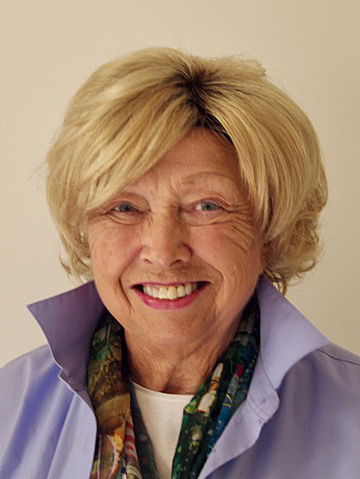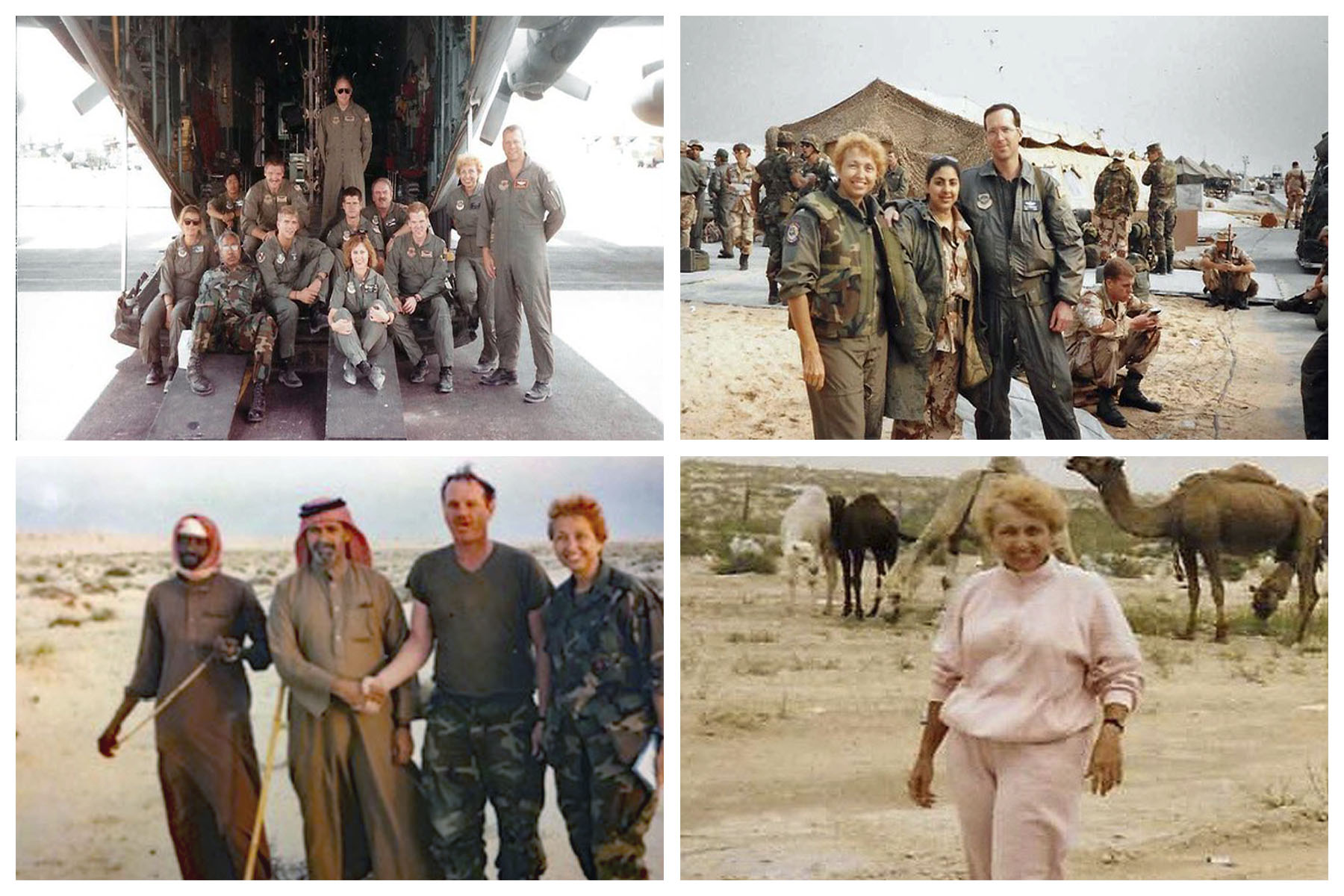U.S. Air Force Vietnam War / Desert Storm La Grange, IL Flight date: 10/06/21
By David Adams, Honor Flight Chicago Veteran Interview Volunteer
Betty Lou Paps, nee Bonwell, was born and reared in lush farm country just south of Danville, Illinois. The middle child of five, Betty reveled in the country life, riding her horse, fishing, and “playing” donkey basketball in high school. Her father Bert, she recalls with pride, frequently had the highest yield of corn and beans in Illinois, thus becoming the “Corn King of Illinois.” Her formal education began in a one-room schoolhouse in Scottland, Illinois. After a year, her education continued in a larger, consolidated school. Her high school class of 1955 graduated thirteen. Following graduation, she was faced with the expectation of becoming a secretary, a school teacher, a nurse, or marrying and becoming a housewife. She said, “Oh, I’ll become a nurse because that’s only three years and becoming a teacher takes four years.” A premonition of things to come: when Betty first became a nurse, she considered the Navy because “back then we wore nurses caps, and I thought the Navy had the prettiest nursing cap.” As we will see, the Navy’s loss would be the Air Force’s gain.
Betty took her nurse’s training at Lakeview Hospital in Danville. She also completed several college courses at Danville Area Community College as part of the nursing curriculum. Betty became a fully registered nurse by the young age of twenty in 1958. After a few years of clinical practice in hospitals including the operating room, she decided to teach; the college courses she had completed earlier helped her to qualify. First, she taught practical nurses in Danville and then sought and earned a bachelor’s degree at the University of Illinois-Chicago. Married by then and with the first of two daughters, she continued her teaching career. She first taught in the diploma program at Mount Sinai Hospital and then at Kennedy-King College in Chicago. Next came a second daughter and a Master of Science in Nursing (MSN) from DePaul and a PhD in Counseling awarded by LaSalle University. In all, Betty taught nursing for twenty-seven years at Kennedy-King and secured national accreditation for one of the nursing programs, the first for any in Chicago.
In 1974 she got a call from a friend who remarked, “Betty, I think you should join the Air Force.” She remembers thinking, “Well, I’ve got two kids and I’m working on my doctorate and so forth, and well a challenge.” She was mentored and encouraged by famed General Wilma Vaught, a close neighbor and family friend from her hometown. With her years of nursing experience, she was commissioned a captain. Upon learning this, her youngest daughter, age five, said, “You’re no captain, you’re my mommy!”


An Air Force Reserve aeromedical unit had relocated to O’Hare from downstate and needed nurses. She applied and was accepted into the 63rd Aeromedical Evacuation Squadron (AES). She learned that the squadron’s mission was to evacuate wounded military personnel and civilians from areas of danger to medical facilities with the use of military transport aircraft. In order to qualify as a flight nurse, Betty went straight to flight school at Brooks Air Force Base, San Antonio, Texas. The six-week curriculum included such instruction as wildness-type survival, physiology of flight with emphasis on how altitude affects the body, and the altitude chamber.
Upon her return to Chicago from Brooks, she continued teaching and contributed to the mission of the 63rd AES. Betty recalls that she, her nurses, medical technicians, and flight crews trained incessantly. Training evacuation flights were required from O’Hare to air bases around the United States on a regular basis. Patients and their medical conditions were simulated. Betty says that such flights consisted of a five member medical crew – two nurses and three medical technicians. The squadron flew the C-130 Hercules described by Betty as a “good solid plane.” She later learned during Desert Storm that it handily dealt with unimproved landing “strips” in the middle of the desert. Betty also became familiar with other transports used for medevac missions such as the C-9 Nightingale and C-141 Starlifter. She became Chief Flight Nurse after about six years in the unit.
A few months after she pinned on her colonel’s eagles, she was called up for active duty in December, 1990 in preparation for Desert Storm, the First Gulf War. She recalls that military planners anticipated significant casualties, thus the need for medical evacuation capability. With just two weeks’ notice before deployment, she and sixty of her “troops,” as she called them, sorted out their personal affairs and flew in the squadron C-130 to Dover, Delaware. Betty rejected the first C-5 Galaxy transport headed for Saudi Arabia because “it was full of bombs.” After landing in Riyadh and settling in, Scud missiles began raining down. “No problem, the defenses stopped them,” according to Betty. Shortly thereafter, she dispatched her crews to such places as Bahrain and the UAE. Most crews, including Betty as commander, were based out of King Fahd International Airport “in the middle of the desert” yet close to Iraq. After seventeen years of intensive training in the States, they all were thoroughly prepared.
As a senior officer she lived in a comfortable tent, but a tent nonetheless. Her base offered four chow halls; picking one day-after-day was not easy. The base was considered United States territory, so it had the usual amenities including swimming pools and a BX. Her crews were on call for a set period of time and then off. Off hours often found Betty out in the desert with a colleague and a couple of Bedouins looking for wild camels.
She remembers a particular night sortie which was tasked to fly up to the Iraqi border and pick up two coalition soldiers. Only one showed, so they dropped him off at his destination. Before returning to base, her plane was diverted to the King Khalid Military City to pick up over fifty prisoners of war. Many prisoners required IVs or chest tubes as well as monitoring of high temperatures and dehydration. Betty recalls four military police getting on the plane saying, “Oh, we can finally rest.” “No way,” she replied. She strategically stationed them in the C-130 to provide security, her decision prompted by the ultimately false rumor that one of their doctors had been killed by a prisoner of war. Betty’s philosophy concerning “the enemy” is that the medical service views combatants as human beings albeit with differing perspectives or goals. “As nurses, we take care of all people,” she asserts.
Betty returned to Chicago in April in time to celebrate her wedding anniversary. Her six months of active duty ended in June, 1991 and she returned to full-time teaching.
Betty retired from the USAF Reserves in 1994 after 20 years of service with the rank of Colonel, proudly wearing the Chief Flight Nurse Badge. She has these awards and decorations: Meritorious Service Award, Air Medal, Air Force Commendation Medal, Combat Readiness Award with two oak leaf clusters, National Defense Service Medal, Southwest Asia Service Award, Armed Forces Reserve Award, and Kuwait Liberation Medal.
She taught for two years past her USAF retirement until 1996 when she retired from teaching. Now a widow, she has two daughters, a grandson, and twin great-granddaughters upon whom she dotes. She is and always has been an avid golfer. Her Lake Geneva condo sports her many tournament awards. Her Florida condo may have just as many. Travel is in her blood having ventured to all seven continents. There are not many countries which have not seen her presence. She admits it is nearly impossible to pick a favorite but Easter Island, Nepal, and Tibet are among them. Next on her travel list is Mongolia and South Korea.
With a lifetime of memories from work, family, travel, and service, Betty reminds us, “there’s always something to learn.”
Thank you, Betty, for your dedication and many years of distinguished service! Enjoy your special day of honor in Washington D.C. with your comrades-in-arms as a member of “Operation Her Story.”


